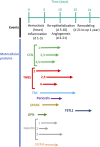Matricellular proteins in cutaneous wound healing
- PMID: 36506087
- PMCID: PMC9730256
- DOI: 10.3389/fcell.2022.1073320
Matricellular proteins in cutaneous wound healing
Abstract
Cutaneous wound healing is a complex process that encompasses alterations in all aspects of the skin including the extracellular matrix (ECM). ECM consist of large structural proteins such as collagens and elastin as well as smaller proteins with mainly regulative properties called matricellular proteins. Matricellular proteins bind to structural proteins and their functions include but are not limited to interaction with cell surface receptors, cytokines, or protease and evoking a cellular response. The signaling initiated by matricellular proteins modulates differentiation and proliferation of cells having an impact on the tissue regeneration. In this review we give an overview of the matricellular proteins that have been found to be involved in cutaneous wound healing and summarize the information known to date about their functions in this process.
Keywords: Skin; extracellular matrix; non-structural matrix proteins; re-epithelialization; regeneration.
Copyright © 2022 Cárdenas-León, Mäemets-Allas, Klaas, Lagus, Kankuri and Jaks.
Conflict of interest statement
The authors declare that the research was conducted in the absence of any commercial or financial relationships that could be construed as a potential conflict of interest.
Figures


Similar articles
-
Matricellular Proteins in the Homeostasis, Regeneration, and Aging of Skin.Int J Mol Sci. 2023 Sep 19;24(18):14274. doi: 10.3390/ijms241814274. Int J Mol Sci. 2023. PMID: 37762584 Free PMC article. Review.
-
Matricellular proteins: From cardiac homeostasis to immune regulation.Biomed Pharmacother. 2024 Nov;180:117463. doi: 10.1016/j.biopha.2024.117463. Epub 2024 Sep 20. Biomed Pharmacother. 2024. PMID: 39305814 Review.
-
Role of matricellular proteins in cardiac tissue remodeling after myocardial infarction.World J Biol Chem. 2010 May 26;1(5):69-80. doi: 10.4331/wjbc.v1.i5.69. World J Biol Chem. 2010. PMID: 21540992 Free PMC article.
-
Matricellular Proteins: Functional Insights From Non-mammalian Animal Models.Curr Top Dev Biol. 2018;130:39-105. doi: 10.1016/bs.ctdb.2018.02.003. Epub 2018 Mar 26. Curr Top Dev Biol. 2018. PMID: 29853185 Review.
-
Extracellular Matrix and Dermal Fibroblast Function in the Healing Wound.Adv Wound Care (New Rochelle). 2016 Mar 1;5(3):119-136. doi: 10.1089/wound.2014.0561. Adv Wound Care (New Rochelle). 2016. PMID: 26989578 Free PMC article. Review.
Cited by
-
Involvement of Matricellular Proteins in Cellular Senescence: Potential Therapeutic Targets for Age-Related Diseases.Int J Mol Sci. 2024 Jun 15;25(12):6591. doi: 10.3390/ijms25126591. Int J Mol Sci. 2024. PMID: 38928297 Free PMC article. Review.
-
Electrospun Nanofiber Scaffolds Loaded with Metal-Based Nanoparticles for Wound Healing.Polymers (Basel). 2023 Dec 20;16(1):24. doi: 10.3390/polym16010024. Polymers (Basel). 2023. PMID: 38201687 Free PMC article. Review.
-
Matricellular Proteins in the Homeostasis, Regeneration, and Aging of Skin.Int J Mol Sci. 2023 Sep 19;24(18):14274. doi: 10.3390/ijms241814274. Int J Mol Sci. 2023. PMID: 37762584 Free PMC article. Review.
-
Pathological Changes in Extracellular Matrix Composition Orchestrate the Fibrotic Feedback Loop Through Macrophage Activation in Dupuytren's Contracture.Int J Mol Sci. 2025 Mar 28;26(7):3146. doi: 10.3390/ijms26073146. Int J Mol Sci. 2025. PMID: 40243889 Free PMC article.
-
Sea lice (Lepeophtheirus salmonis) life stage impacts atlantic salmon transcriptomic responses under different thermal profiles.Front Genet. 2025 Jul 29;16:1633603. doi: 10.3389/fgene.2025.1633603. eCollection 2025. Front Genet. 2025. PMID: 40799220 Free PMC article.
References
-
- Acharya C., Yik J. H., Kishore A., Van Dinh V., Di Cesare P. E., Haudenschild D. R. (2014). Cartilage oligomeric matrix protein and its binding partners in the cartilage extracellular matrix: Interaction, regulation and role in chondrogenesis. Matrix Biol. 37, 102–111. 10.1016/j.matbio.2014.06.001 - DOI - PubMed
Publication types
LinkOut - more resources
Full Text Sources

